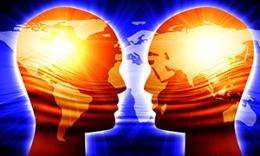Numerical simulation provides insights into social attitudes

A Singaporean computer scientist and his American colleague have created a computer simulation of how humans perform on a widely employed test of implicit or unconscious social attitudes, particularly racial bias.
The success of their model opens the way to undertaking experiments virtually, which cannot be conducted in real human subjects, and exploring the factors underlying the formation of such social biases. "This will help us to better account for people's behavior as a function of their attitudes and beliefs, and possibly provide some insight into consumers' tastes, preferences and purchasing habits," says Boon-Kiat Quek of the A*STAR Institute of High Performance Computing, who carried out the study with Andrew Ortony of Northwestern University in the United States.
The Implicit Association Test (IAT), first published in 1998, is designed to test a person's internal association between concepts and objects, such as whether insects or flowers are deemed pleasant or unpleasant. The computer-based test requires participants to sort concepts or objects flashed on the screen into one of two categories by pressing a left- or right-hand key. The system records the time taken to make each choice.
The IAT is now widely employed in many different forms in studies of social psychology, and has been used as evidence for the existence of society-wide unconscious or implicit social preferences, such as young over old. Another widely publicized result is that almost all white people show an apparent bias for whites over blacks, whereas only about half of the black individuals tested prefer blacks over whites.
Quek and Ortony, however, could see nothing in the IAT that would allow them to decide whether or not those attitudes were strictly positive or negative, or if—for instance—people had positive attitudes towards both whites and blacks, but preferred one more than the other. They also found no indication of the absolute strength of the bias. To explore these issues, they developed a computational model representing the steps involved in processing the IAT in humans.
Using their relatively simple model, Quek and Ortony were able to replicate human performance on the IAT. They argue that such models could be useful in providing data on unconscious assumptions that could not be obtained otherwise, because the memories and brains of human subjects cannot be taken apart and manipulated.
"There are many possible extensions of this work," says Quek. "For instance, performing virtual experiments to understand how people acquire the implicit attitudes that they possess."
More information: Quek, B.-K. & Ortony, A. Assessing implicit attitudes: What can be learned from simulations? Social Cognition 30, 610–630 (2012). guilfordjournals.com/doi/abs/1 … 1/soco.2012.30.5.610












